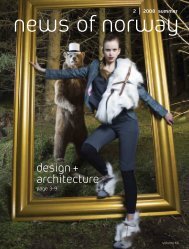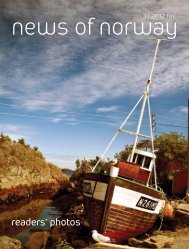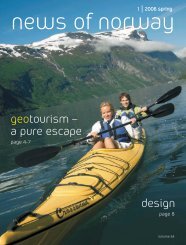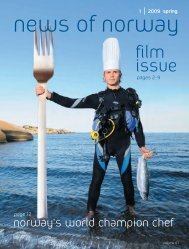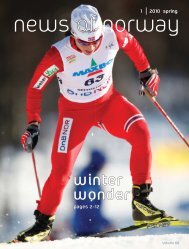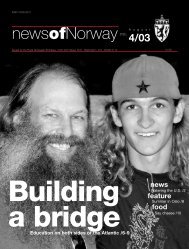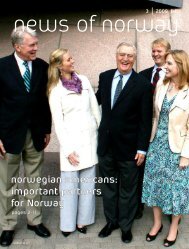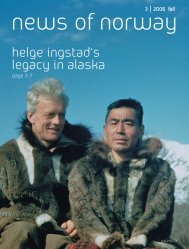News of Norway
News of Norway
News of Norway
- No tags were found...
You also want an ePaper? Increase the reach of your titles
YUMPU automatically turns print PDFs into web optimized ePapers that Google loves.
1 2008 springnews <strong>of</strong> norwaybiotech:a growing futurepage 3-5Volume 66
dear readerPoliticians call upon new technology to solve our climate crisis and find alternative energy.Facing global and national health challenges we look to biotechnology in search for therapiesand diagnostics. How do we find solutions? Collaboration, <strong>of</strong> course.Last fall, <strong>Norway</strong>’s Minister <strong>of</strong> Research and Higher Education attended Science Week atthe Carnegie Institution aiming to energize transatlantic cooperation. The deputy minister followedup with a visit to the West Coast this spring. Political advisers from the NorwegianParliament met with colleagues on Capitol Hill, to discuss science and technology prospectsand policies. Education is key. Both U.S. and Norwegian legislators must encourage youth tochoose science and technology education to prepare for the future.Recent changes in <strong>Norway</strong>’s biotechnology legislation opened for researchon unused human fertilized eggs, and for genetic testing <strong>of</strong> human embryosbefore implantation. Stem cell research receives government funding.International research partners see great potential in Norwegian biobanksand health registries. However, there are ethical and regulatory challenges;who owns the biological material, genetic information and patient data?Overselling <strong>of</strong> biotechnology to cure cancer happens almost daily.Adding stem cells to organ transplants created hype in The Economist recently.Some speak <strong>of</strong> trading with biodiversity quotas, while others promotegenetically modified corn and soy. Will a seed bank in Svalbard save us?Skin cells can now be used to make stem cells. True or overselling?International collaboration in research and innovation is essential toanswer these questions. The research frontiers are international. The U.S hasthe leading institutions, but Europe and the rest <strong>of</strong> the world are advancing fast. Competition istough. However, statistics and publications confirm that <strong>Norway</strong> is a competitive and attractivepartner. <strong>Norway</strong> may be small, but we have world class research centers. Innovation in biomedicine,bioenergy and clean technology create new businesses. But an advantage in the U.S.is that a biotech company is funded and grows almost six times as fast as in <strong>Norway</strong>.It is time to look to North America. <strong>Norway</strong> must collaborate with the best biotech and lifescience clusters, and also pay attention to U.S. partners interested in working with <strong>Norway</strong>.Cooperation creates dialogue and innovative results with global impact.PHOTOS BY EVA BRÆNDDr. Berit JohneCounselor for Science and Technology, Norwegian EmbassyRoyal Norwegian Embassy2720 34th. St., NWWashington, D.C. 20008(202) 333-6000www.norway.orgAMBASSADORWegger Chr. StrommenCOUNSELOR, COMMUNICATIONSJannicke JaegerEDITORArild StrommenEDITORIAL ASSISTANTCaroline SchonheyderSUBSCRIPTION<strong>News</strong> <strong>of</strong> <strong>Norway</strong> (ISSN: 0028-9272)is published by the Royal NorwegianEmbassy in Washington, D.C. Themagazine was founded in 1941 andreaches 36,000 subscribers in the UnitedStates and Canada. For a free subscription,write or call with your name andaddress, or send an email tosubscription@norway.orgPHOTO: THE NORWEGIAN ACADEMY OF SCIENCEThe $1.2 million Abel Prize wasawarded mathematician JohnGriggs Thompson <strong>of</strong> University<strong>of</strong> Florida and Jacques Tits fromFrance. The award will be presentedby King Harald V <strong>of</strong><strong>Norway</strong> in Oslo on May 20. TheNorwegian Academy <strong>of</strong> Sciencecited the winner’s “pr<strong>of</strong>oundachievements in algebra and inparticular for shaping moderngroup theory.” “The achievements<strong>of</strong> John Thompson and <strong>of</strong>Jacques Tits are <strong>of</strong> extraordinarydepth and influence. They complementeach other and togetherform the backbone <strong>of</strong> moderngroup theory,” stated the Abelcommittee. More information atwww.abelprisen.no/enKing Harald V has bestowed theMedal <strong>of</strong> St. Olav on MarianneForssblad, former Director <strong>of</strong> theNordic Heritage Museum inSeattle, for her outstanding serviceto Norwegian interests duringher 27 years at the museum. TheNordic Heritage Museum wasfounded in 1980 and highlightsthe contributions <strong>of</strong> Nordic immigrantsand their descendants inthe development <strong>of</strong> the PacificNorthwest. King Haakon VIIfounded the Medal <strong>of</strong> St. Olav in1939. It is awarded for outstandingservice in advancing knowledge<strong>of</strong> <strong>Norway</strong> and strengtheningthe bonds between expatriateNorwegians and descendants andtheir country <strong>of</strong> residence.PHOTO BY KSATabel prize medal <strong>of</strong> st. olav environment anti-discrimination<strong>Norway</strong> now run satellite stationsto monitor global climate changein both the northern and southernpolar regions. Together, theTrollSat station in the Antarcticand SvalSat in the Arctic enablerapid download <strong>of</strong> environmentaldata from satellites passing overthe poles. “The TrollSat satellitestation is a milestone in environmentalmonitoring by satellite,”said Norwegian Prime MinisterJens Stoltenberg when openingthe Antarctic station in January.Data will be received from bothU.S. and European satellites.<strong>Norway</strong> is the only nation withterritorial claims and administrativeresponsibilities in both theArctic and the Antarctic.PHOTO BY WFP/KHALED MANSOURCombating discrimination willplay an increased role in<strong>Norway</strong>’s foreign aid programs,said Erik Solheim, NorwegianMinister <strong>of</strong> the Environment andInternational Development. “Wecannot accept discrimination ongrounds <strong>of</strong> race, gender or sexualorientation. The gender perspectiveis important in developmentcooperation because women areparticularly severely affected bypoverty; and it makes sense tocombat discrimination from aneconomic point <strong>of</strong> view. It is difficultto achieve economicgrowth if half <strong>of</strong> the population isexcluded from development,”said Mr. Solheim on March 8,International Women’s Day.2 | news <strong>of</strong> norway | spring 2008
efficacy are subsequently tested out in the dedicated Phase 1 unit at theNorwegian Radium Hospital.The institute and the hospital also have access to a large quantity <strong>of</strong>patient sample material from the Norwegian Cancer Registry. This registryis to the benefit <strong>of</strong> research and development <strong>of</strong> new therapeuticregimes and diagnostic tests in collaboration with OCC members andother international partners, like pharmaceutical giant AstraZeneca.<strong>Norway</strong>’s university hospitals and OCC have a strong commonality interms <strong>of</strong> diagnosing and treating cancer through researching, developing,and applying cutting-edge knowledge and science. Because <strong>of</strong> themembers’ strong common intent and collaborative relationships, OCCwith its 40-plus member base <strong>of</strong> fledgling biotech companies andresearch institutions is able to stimulate and drive translationalresearch from laboratory research to the clinic in a novel and veryeffective manner.R&D spending and directionPublic R&D spending in <strong>Norway</strong> is underpinned by the country’sgreat wealth <strong>of</strong> natural resources and economic prosperity.<strong>Norway</strong> is the world’s third largest exporter <strong>of</strong> oil and gas, theeconomy is currently enjoying strong growth with high oil prices, aubiquitously strong currency, the Norwegian krone, and low unemploymentlevel.In 2005, total R&D expenditure from public and private sourcesreached $5.9 billion, or about 2 percent <strong>of</strong> GDP. This is on the low sidecompared to <strong>Norway</strong>’s closest neighbors and the Norwegian governmenthas pledged to increase spending on R&D to 3 percent <strong>of</strong> GDPby 2010. However, it should be noted that R&D in energy and naturalresources sectors is not classified as investment in high-tech sectors,causing underreporting <strong>of</strong> actual investment.Most public spending on R&D is directed by the ResearchCouncil <strong>of</strong> <strong>Norway</strong>. In addition to funding basic research, theCouncil supports three major programs for nurturing biotech:FUGE, a functional genomics project; PROSBIO, for research in bioprocessing;and MABIT, stimulating marine bioprospecting. While thepublic research sector has long had a mission to transfer knowledge toindustry, it is acknowledged that private-public research links could bestrengthened further, for example by making it easier for public sectoremployees to be seconded to the private sector without loss <strong>of</strong> benefits.<strong>Norway</strong> understands it needs to get its national innovation system runningefficiently, and a white paper on innovation is due to be publishedin the spring <strong>of</strong> 2008.More funds for company formationIn a recent survey <strong>of</strong> innovation in <strong>Norway</strong>, the OECD concludedthe government has set ambitious goals and that programs to allocatepublic support for innovation and tax deductions are “generallywell designed and regularly evaluated.”For example, 2002 saw the setting up <strong>of</strong> an R&D tax credits system,Skattefunn. In addition, the government has started a number <strong>of</strong>seed funds, and called for cooperation between public andprivate investors to provide Norwegian knowledge-basedindustries with long-term capital.One example is the Sarsia Seed Fund,a $66.7 million fund financed 50 percentby the government and 50percent by the private sector.At present Sarsia is<strong>Norway</strong>’s only seed fundspecializing in life sciences.In most countriesit is the medicalapplications <strong>of</strong>biotechnologythat are mostdeveloped, but in <strong>Norway</strong> marine biotechnology is equally prominent.A handful <strong>of</strong> Norwegian-based venture capital firms back life sciencescompanies, including Neomed Management, Teknoinvest, SarsiaManagement, Selvaag Venture Capital and SakornInvest Management.And there is growinginterest in the Nordiccountries from overseasinvestors, whoare increasingly gettinginvolved in earlystage deals – thoughto date they have concentratedon energyand ICT companies.<strong>Norway</strong> recognizes the need to further increase levels <strong>of</strong> venture capital,which according to the OECD stood at 0.2 percent <strong>of</strong> GDP in 2005,compared to 1.2 percent and 0.8 percent in Denmark and Sweden.Norwegian biotech companies have had good support from localinvestors, as demonstrated by Affitech, a therapeutic antibodycompany. In its most recent private round <strong>of</strong> financing, the companyraised $13 million from local venture capital firms, includingTeknoinvest, Ferd Venture, Verdane (formerly Four Seasons Venture),Braganza, which is a privately held investment company, and ArendalsFossekompani, an energy company that invests in Norwegian startups.The longest established Nordic venture capital firm, TeknoinvestManagement, founded in 1984, has been a long-standing supporter <strong>of</strong>one <strong>of</strong> <strong>Norway</strong>’s oldest biotechs, Photocure, established as a spin-<strong>of</strong>ffrom the Norwegian Radium Hospital in 1993 to develop photodynamictherapies. Photocure is the leader <strong>of</strong> <strong>Norway</strong>’s growing band <strong>of</strong>biotechs that have made it to the public market, joining the Oslo StockExchange in 2000. The most recent to join the club was Algeta, a specialistin nuclear medicine, which joined up in March last year.Biomarker-based diagnostics specialist DiaGenic was listed in August2004, followed to market by Biotec Pharmacon in October 2005,Nordiag in December 2005, and Navamedic and Clavis Pharma inMarch and July 2006, respectively.practical biotechnology<strong>Norway</strong> <strong>of</strong>fers anenvironment wherebiotech can prosper.A group <strong>of</strong> political advisers from the NorwegianParliament extracted their own DNA during a visit to theCarnegie Institution for Science in Washington, D.C. inJanuary. Pictured are Reidar Ryssdal from the socialist leftparty and Gunn Lyngvær from the Labor Party.www.norway.org | 4
y arild strømmen‘The Bone Reconstructor’Dr. Mikko Larsen is looking for a successful method to transplantlive bone in patients who need reconstruction <strong>of</strong> large bonedefects. “Most methods <strong>of</strong> reconstruction to date involve usingdead bone, which heals incompletely and has a high complicationrate,” Dr. Larsen said. Successfully using bone transplants that arealive – with the same shape and healing properties <strong>of</strong> the bone a patientis missing – would be a biotechnological breakthrough.Born to Norwegian and Dutch parents, Dr. Larsen is spending ayear at the Mayo Clinic’s Microvascular Research Laboratory <strong>of</strong> theDepartment <strong>of</strong> Orthopedics in Rochester, Minnesota. There, he is hardat work with research that aims to find a way around current obstacles.“When we use living bone from the same patient, the healing is betterbut there is <strong>of</strong>ten a huge size and strength mismatch, for example whenyou use the fibula to reconstruct the femur. The problem with using aliving bone transplant, as opposed to a dead bone transplant, is that youneed strong immunosuppression drugs to prevent the tissue from beingrejected,” he said – and taking such drugs on a permanent basis representrisks that may outweigh the benefit for conditions that are not lifethreatening.“When you receive a new heart or lung you are willing totake the immunosuppression, but to save your arm or leg, the risk-benefitratio might be totally different. So what we are looking for is a wayto do the living bone transplantation in such a way that your body willaccept the new bone even after the immunosuppression is stopped aftera time.”The methodology to achieve this goal, is enhancing bone with alarge blood vessel from the recipient, that grows into the boneand replaces the blood supply from small vessels that have beenattached. By the time the immunosuppression is stopped, the bloodsupply to the bone is “switched” and only the original vessels arerejected by the body. The new blood vessels should survive, since theybiotechlinksResearch Council <strong>of</strong> <strong>Norway</strong>:www.rcn.noInnovation<strong>Norway</strong>:www.innovationnorway.comNorwegian Center for International Cooperation in HigherEducationwww.siu.no/enResearch and higher education in <strong>Norway</strong>:www.studyinnorway.noMinistry <strong>of</strong> Education and research:www.regjeringen.no/en/dep/kdRoyal Norwegian Embassy in Washington, research andtechnology:www.norway.org/restechscience weekSave the date for Transatlantic Science Week 2008 inOttawa and Washington, D.C. October 20-23.Themes: “Health – Energy – Global Impact”Special workshop on cancer research and innovation.For program, registration information and updates see:www.norway.org/restechbelong to the patient. “The method has worked very well in the laboratoryand we have seen new bone being made a long time afterimmunosuppression has been stopped,” Dr. Larsen said. He is performingthe study using microvascular bone transplantation on smallanimal models and then investigates the mechanisms <strong>of</strong> bone healingand growth after bone is transplanted with the blood vessels attachedto feed it. A microscope is used to attach these blood vessels. “The vesselsare usually about 0.6 millimeter in diameter and the needle andthread that we use could tie a knot through a human hair,”Dr. Larsen said.“For the patient our research <strong>of</strong>fersmethods that in the future may greatlyimprove the results from largereconstructive surgeries. For methis is a great way to learnhow to conduct a largeresearch project andwork as a team withanalysts in diversefields <strong>of</strong> medicine,from surgery tomolecular biologyto polymer science,”he said.5 | news <strong>of</strong> norway | spring 2008
society & policyPHOTO BY ARILD STRØMMENPHOTO BY JON BERGForeign Minister Jonas Gahr Støre met with Secretary <strong>of</strong> StateCondoleezza Rice in Washington, D.C.MINISTERS STØRE AND SOLHEIM IN THE U.S.by arild strømmenForeign Minister Jonas Gahr Støre met Secretary <strong>of</strong> StateCondoleezza Rice and former Vice President Walter Mondale ona three-city visit to the United States in March. In Minneapolis,Mr. Støre and Mr. Mondale, who assumes the position <strong>of</strong> NorwegianConsul General in Minnesota this summer, spent time with leaders <strong>of</strong>the Norwegian-American community to discuss how to continue tocultivate the strong bonds that exist between <strong>Norway</strong> and the Midwest.“We have a good understanding and a common ground. Our meeting<strong>of</strong> minds here in Minnesota and in the broader Midwest encapsulatesour opportunity. We will do everything we can to maintain theclose relations we have today and to develop them further as we lookahead to the future,” the Foreign Minister said in a public speech at theHubert Humprey Institute <strong>of</strong> Public Affairs.“My ambition for <strong>Norway</strong>’s relations with the United States in theyears to come is that we will seize these opportunities to make a differencetogether. We are partners in security, in NATO, and right nowwe are working side by side to help Afghanistan on its feet. We havesuch an extraordinary common ground for meeting contemporary challenges:our history and heritage, our ties <strong>of</strong> friendship, our exchanges<strong>of</strong> students and experts, our willingness to cooperate and – not least –our determination to find solutions.” You may read the entire speech atwww.norway.org/policy/speechesStøre also gave a keynote address titled “Global Health and theForeign Policy Agenda” at the Conference on the State <strong>of</strong> the Planet inNew York, a conference held biannually by The Earth Institute atColumbia University.In Washington Støre met with Secretary <strong>of</strong> State Condoleezza Rice,U.S. Trade Representative Susan Schwab, and political advisors. Healso participated in a think-tank roundtable discussion on how theinternational community can build a foundation for security and developmentin Afghanistan, a country to which <strong>Norway</strong> contributes bothmilitarily and with substantial development assistance.Minister <strong>of</strong> Environment and International Development ErikSolheim at solar energy company SolFocus in California.Minister <strong>of</strong> Environment and International Development ErikSolheim met with government agencies in Washington andgreen energy companies in California in January.“California is widely known for its progressive environmental policiesand has taken a leading role in the U.S., which makes it veryinspiring to visit the state,” Mr. Solheim said.In Sacramento Mr. Solheim and his delegation discussed environmentalpolicy and climate change at the California EnvironmentProtection Agency. The Minister continued with meetings at theCalifornia Resources Agency and the California Energy Commission.Mr. Solheim addressed students and staff at UC Berkeley as aspeaker and panelist at the conference “Focus the Nation.” He also visitedAmyris Biotechnologies, a company engaged in advanced researchon the next generation <strong>of</strong> bi<strong>of</strong>uels and biodiesel, and test drove ahydrogen fueled vehicle at the California Fuel Cell Partnership. InSilicon Valley he learned about advanced solar energy generation at thecompany SolFocus, and met with the Green Energy team at Google.In Washington, D.C., the minister had meetings at the White HouseCouncil for Environmental Quality, the U.S. Environmental ProtectionAgency, and the Department <strong>of</strong> Energy, and with environmental organizationsand think tanks, such as the World Resources Institute,Climate Policy Center, Bellona, and the World Wildlife Fund. Theyexchanged views on how both <strong>Norway</strong> and the U.S. can move forwardon environmental initiatives, and come up with measures that are politicallyand economically doable at the same time as being environmentallypowerful.Minister Solheim presented several priorities for <strong>Norway</strong>, highlightingmeasures to combat deforestation. “<strong>Norway</strong> would like toengage in projects which can reap measurable results in the short run,”Mr. Solheim said. “Such an initiative may bring about substantial cutsin greenhouse gas emissions while the world is seeking to put in placea new, more comprehensive agreement on climate change.”6 | news <strong>of</strong> norway | spring 2008
LESSONS FROM PEACE DIPLOMACYINSPIRE REPRESENTATIVE KEITHELLISON ON VISIT TO NORWAYby caroline schønheyderKeith Ellison, aMinnesota representative(D) in theHouse, visited <strong>Norway</strong> inearly January. Ellisonwanted to learn from<strong>Norway</strong>’s peace efforts, aswell as about the roots <strong>of</strong>his constituents.In an interview with theNorwegian newspaperAftenposten, Ellison spokewarmly <strong>of</strong> <strong>Norway</strong>’sefforts to promote peaceand reconciliation. Ellisonemphasized that peaceprocesses create hope:“When there is no process,hopelessness will surface,followed by despair andthen by murderousthoughts. Processes keepthe hope going.” Ellison issupporting legislationseeking to establish a cabinet-levelPeaceDepartment in the U.S. Inanother interview with StarTribune, Ellison stated,”This trip … helps me tosee that it is an importantpart <strong>of</strong> legislation that I’llpush with renewed energy and vigor … Iintend to continue to organize communityaround peaceful resolutions <strong>of</strong> conflict.” Healso pointed out that <strong>Norway</strong> has establishedwhat he called a “culture <strong>of</strong> peace.” If the U.S.would acquire the same kind <strong>of</strong> peace-makingskills <strong>Norway</strong> has, Ellison continued, conflictssuch as the war in Iraq could be avoided.Ellison said he is very much aware <strong>of</strong> theNorwegian-American heritage in Minnesota,and how much it means to his constituents.According to Ellison, this heritage putsemphasis on social responsibility and on “thepublic interest.” The most important matterson Ellison’s political agenda are the promotion<strong>of</strong> peacekeeping work, improving conditionsfor America’s poor, extending healthinsurance to those who cannot afford it, maintainingequality <strong>of</strong> law and the prevention <strong>of</strong>human rights violations. The trip to <strong>Norway</strong>thus seemed fitting.In <strong>Norway</strong>, Ellison met former PrimeMinister Kjell Magne Bondevik, who is nowpresident <strong>of</strong> the Oslo Center for Peace andHuman Rights. The congressman also metwith representatives from the InternationalIn <strong>Norway</strong> Keith Ellison, a Minnesota representative (D) in the House, metwith former Prime Minister Kjell Magne Bondevik, who is now President <strong>of</strong>the Oslo Center for Peace and Human Rights.Peace Research Institute and the NorwegianInstitute <strong>of</strong> International Affairs (NUPI),headed up by Jan Egeland, a former undersecreatary-generalfor Humanitarian Affairs atthe United Nations. Egeland has beendescribed by Time Magazine as one <strong>of</strong> theindividuals who shape our world. Ellison wasimpressed by <strong>Norway</strong>’s peace efforts, and byits willingness to communicate with partieswith which it disagrees. In that respect, he wasalso impressed by the open dialogue betweenthe Norwegian government and NorwegianMuslim communities.<strong>Norway</strong> is strongly committed to environmentalprotection and fighting climatechange, something that did notescape Ellison on his trip. He met with theDean <strong>of</strong> the Norwegian University <strong>of</strong> Life andSciences, which works with the University <strong>of</strong>Minnesota on climate change issues. “Thisoil-rich nation has not sacrificed its commitmentto renewable energy,” Ellison told StarTribune.Ellison is not the first U.S. government<strong>of</strong>ficial to visit <strong>Norway</strong>. Each year, theNorwegian government hosts a group <strong>of</strong> representativesfrom the U.S. Congress and theirstaffers, through the Norwegian-AmericanParliamentary Exchange Program (NAPEP).On the American side, these programs cater inthe most part to members <strong>of</strong> the <strong>Norway</strong>Caucus, <strong>of</strong> which Ellison is a member.Ellison is the first member <strong>of</strong> Congress todeclare himself a Muslim, and he createdquite a bit <strong>of</strong> commotion when he insisted onbeing sworn into <strong>of</strong>fice with his hand on hisQuran. Ellison represents the Democratic-Farmer-Labor Party (DFL), and calls himselfa true Democrat. “Its your values and yourpolitical platform that decides whether youget people’s support,” Ellison toldAftenposten, explaining why his constituency<strong>of</strong> Norwegian, Swedish and German ancestryhad chosen him to represent them inCongress.www.norway.org | 7PHOTO BY ERLING RIMESTAD
PHOTO BY LINA TØRUM<strong>Norway</strong> rocks in Texasby arild strømmenPunishing their guitars, and giving the drum-set a beating,Ungdomskulen brought the house down – or maybe the tent likestructure at Maggie Mae’s ro<strong>of</strong>top – at the South by Southwestmusic festival in Austin, Texas, in March. “We played as if there wasno tomorrow and no yesterday,” said the band, pictured above.An “underground” act, the three guys who make up the band createdbuzz even in the unlikely-to-write-about-them Wall Street Journal…whose rock music critic wrote: “The witty and talented groupUngdomskulen traveled 26 hours from <strong>Norway</strong> to play two sets andleft with new contacts – including, I’m told, a new booking agent. Hewas trying to get a label to issue the band's new album, which is completeand, if the songs on their MySpace page is an indication, awfullygood.”This is what it is all about at the annual industry showcase inAustin, where 16 Norwegian bands tried their luck this year, tobe seen, heard, make contacts, be booked, and hit the concert circuit.Or more aptly put on Ungdomskulen’s blog: “We indie-kids andbiz-people walking hand in hand down the sun-kissed sidewalk, wadingin flyers, posters, and free beer tickets.” With their debut albumCry-baby just set loose they “have laid the first egg to spawn worlddomination.”Still, the best-selling Norwegian music export to the U.S. – blackand death metal – drew the largest crowd. In a back alley just <strong>of</strong>f 6thstreet, Austin’s main drag, the line snaked around the corner for thebash “It’s grim up North.” No worries if we had to wait, though, themusic carried well through the walls. Inside, the make-up <strong>of</strong> deathmetal group 1349 was – eh – deadly. The name represents the year inthe fourteenth century when the “black death” plague spread to<strong>Norway</strong> by an infected ship crew, and eventually eliminated half thecountry’s population. 1349’s latest album in called Hellfire.SXSWorld magazine describes the genre “non-intuitively knownas death metal” as “more melodic and is identified by its unexpectedfrequent changes in time signature, key and tempo. Unlikethe high-pitched guitar and vocal tone <strong>of</strong> black metal, death metalrocks at the deep end <strong>of</strong> the sonic spectrum with low growling vocals.”The event also featured Goat the Head and the better known bandEnslaved.“Grim up North” was largely organized by Music Export <strong>Norway</strong>,an organization dedicated to promoting Norwegian music to an internationalaudience. The state funded agency also had a sprawling boothat the industry trade show, complete with a cushy couch onto whichNorwegian bands were willingly pushed for interviews with MTVEurope’s Norwegian hostess Charlotte Thorstvedt, whoUngdomskulen described as having “haunting beautiful looks and8 | news <strong>of</strong> norway | spring 2008
musicAt left: Ungdomskulen, above: Hanne Hukkelberg, below: 1349.camera charisma,” after their interview.Norwegian media presence also included NRK P1 radio, whichbroadcast a live daytime concert at Leann Atherton’s rustic – asin pretty worn out – but charming hacienda, in the northern part<strong>of</strong> Austin. At the outdoor stage singer-songwriter Hanne Hukkelbergmade an appearance as part <strong>of</strong> her U.S. tour. Her music was s<strong>of</strong>t andmelodious, accompanied by a bass player and a band member alternatingbetween various instruments and intriguing vocals. Her most recentalbum, Rykestrasse 68, won an award at <strong>Norway</strong>’s version <strong>of</strong> theGrammies last year, and has just been released in North America on theNettwerk label.The album has “a brooding and quietly dramatic temperament, andit’s full <strong>of</strong> intricate sonic touches,” wrote the New York Times reviewer.“Her voice, high and pristine, brought ethereality and mystery to thesong.”Other major events at South by Southwest included an evening <strong>of</strong>Norwegian independent label Smalltown Supersound presentingits line-up, and the Øya Festival night <strong>of</strong> six acts from<strong>Norway</strong> and the U.S. The annual Øya Festival in Oslo had 65,000 visitorslast year, and aims to present a cutting-edge bill in <strong>Norway</strong> thissummer, August 5-9.Listen on the web:Bjørn Torskewww.myspace.com/bjorntorskeDiskjokkewww.myspace.com/diskjokkeLindstrømwww.myspace.com/feedelityKim Hiorthøywww.myspace.com/kimhiorthoySilje Neswww.myspace.com/siljenesRalph Myerz Supersoundsystemwww.myspace.com/theshakes4everA-Lagetwww.myspace.com/alagetbergenLars Vaularwww.myspace.com/dlarsSissy Wishwww.sissywish.comwww.myspace.com/sissywishUngdomskulenwww.ungdomskulen.comwww.myspace.com/ungdomskulenGoat The Headwww.goat.as1349www.legion1349.comEnslavedwww.enslaved.nowww.myspace.com/enslavedHanne Hukkelbergwww.hannehukkelberg.comwww.myspace.com/hannehukkelbergShiningwww.myspace.com/gninihsSymewww.myspace.com/symenorwayThe Øya Festivalwww.oyafestival.comwww.myspace.com/oyafestivalSmalltown Supersoundwww.smalltownsupersound.comMusic Export <strong>Norway</strong>www.musicexportnorway.comwww.norway.org | 9
musicstargate to fameby anne myklebustWhen the popularity <strong>of</strong> rhythm and blues skyrocketed at the turn<strong>of</strong> the millennium, it was difficult to imagine Norwegianartists or producers ever significantly influencing this sizzlinggenre. Nevertheless, in the past couple <strong>of</strong> years, the Norwegian producerteam Stargate has established itself at the very center <strong>of</strong> the U.S.R&B scene.Formed in 1997 as a trio, Tor Erik Hermansen, Mikkel StorleerEriksen, and Hallgeir Rustan set up the first Stargate base inTrondheim. Since moving to New York in 2005, they have recorded anumber <strong>of</strong> hits with artists such as Rihanna, Shakira, and Beyoncé,adding to the resonance <strong>of</strong> the Stargate moniker in the U.S. The latesthighlight <strong>of</strong> their careercame in February,when Eriksen andHermansen attendedthe Grammy Awards asdouble nominees thesame week they hadfive productions on theBillboard Top 100.“The reason for oursuccess is not thatwe’re that much differentfrom everybodyelse, but that we havesomething to <strong>of</strong>fer in agenre and market wehave a good understanding and knowledge <strong>of</strong>, and that we producemusic that comes from the heart,” Eriksen said. “Our love <strong>of</strong> musicstarted in the ‘80s with breakdance and rap, and we have always lovedAmerican music. We have been inspired by Prince, Michael Jackson,Depeche Mode, Usher, Destiny’s Child, and R. Kelly.”For Norwegian producers to reach this level <strong>of</strong> success is extraordinary.In the contemporary international R&B market, producersand songwriters have become just as iconic as the artists withwhom they work. Timbaland and theNeptunes are prime examples <strong>of</strong> how the status<strong>of</strong> producers and songwriters has been elevatedin recent years. Today’s producers andsongwriters will typically create a simplesketch <strong>of</strong> a song before pitching it to artistswho may be interested. Depending on therequests and needs <strong>of</strong> the artist, the producers’role in the process <strong>of</strong> completing thetrack will then vary from that <strong>of</strong> backgroundmen to fully credited songwriters. Stargatehave played a variety <strong>of</strong> roles in their mostfamous collaborations, and have garnered areputation as skilled at adapting to artists’styles.In the wake <strong>of</strong> their first international successwith British pop project Hear’Say in1999, Stargate reached a crossroads: theycould either content themselves with being asuccess in <strong>Norway</strong>, with the occasional ventureinto the European market, or aim for biggerthings, which implied a move across theAtlantic.Unfortunately, the trio were not in syncwhen faced with this career choice.Hermansen and Eriksen decided to relocatemore or less permanently to New York threewhat do beyoncé,shakira, andrihanna have incommon? producerteam stargate fromnorway.Stargate team MikkelEriksen and Tor ErikHermansenyears ago, while Rustan stayed behind in <strong>Norway</strong>, where he continuesto work as a producer.Considering their many collaborations with pop artists, moving toan R&B-dominated market may seem bold. However, music punditshave on occasion argued that Stargate’s pop sensibilities have giventhem the upper hand in a music scene <strong>of</strong>ten struggling with the genre.Hermansen and Eriksen must have been well aware that their successin the U.S. depended on their ability to quickly establishrelationships with key artists. And considering their unassumingattitude, one might expect that the two would struggle to forge the necessaryties in such a competitive environment. Three years after themove, the transition to the American market appears to have beenseamless, but anecdotes in the media nevertheless indicate thatHermansen and Eriksen encountered a fair share <strong>of</strong> septicism as relativeunknowns in New York.In an article about the duo’s unlikely rise to fame, the New YorkTimes gave a humorous description <strong>of</strong> the first meeting betweenStargate and rapper Ne-Yo, who had the following to say about his firstencounter with Hermansen and Eriksen in a hallway at Sony MusicStudios: “They told me they did R&B, and honestly I didn’t believethem.” Two years after that chance meeting, Ne-Yo has recorded anumber <strong>of</strong> hits with Stargate, including “So Sick,” which was No 1 onthe Billboard charts for two weeks.Hermansen and Eriksen’s unobtrusiveness appears to be reflectedmusic they produce, and their productions tend to leave the limelightto the person holding the microphone. Their trademark is a spacioussoundscape, destined to appeal to R&B stars who are <strong>of</strong>ten weary <strong>of</strong>competition from the people behind the mixing console. Nevertheless,Stargate leaves an unmistakable imprint on its songs. Steve Lunt, anexecutive at Atlantic Records, made the following observation toTimes: “They’re chameleons. But if you put a bunch <strong>of</strong> Stargate songstogether you will see the thread running through them.”2008 already looks set to become another banner year for Stargate.A key release will likely be Mariah Carey’s new album, E=MC2.Stargate recorded the song “I’m that chick” for this album. Few will bePHOTO BY DUSAN RELJIN10 | news <strong>of</strong> norway | spring 2008
what’s cookingSpice it Upby caroline schønheyderNorwegian TV-chef and writer AndreasViestad spices it up with a new cookbook,food column in the WashingtonPost, and soon to be aired TV series on PBS.Andreas blends his passion for food andwriting into a nice mixture <strong>of</strong> TV shows,books, and articles that are all gaining internationalrecognition. In February, he launcheda monthly column in the Washington Post,called the Gastronomer, on the science <strong>of</strong>everyday cooking. Published at the end <strong>of</strong>2007, his book, Where Flavor was Born, wasnamed best cookbook travelogue <strong>of</strong> the yearby National Public Radio. The book is alsonominated in the best in the world category <strong>of</strong>the Oscars <strong>of</strong> cook-books – Gourmand WorldCookbook Awards. Where Flavor was Borntakes readers on a journey around the IndianOcean on the old spice route, exploring thehome <strong>of</strong> each ingredient and recipe he shares.Curiosity and a wish to pass on his thirstfor new discoveries seem to be the drivingforces behind all his work. Andreas does notsimply let you know how many pounds andounces to put in your pie, he gives you thestory behind the food he prepares and turnscooking and eating into a whole new experience.Andreas has been called “<strong>Norway</strong>’sCulinary Ambassador,” and rightly so.Andreas has been the host <strong>of</strong> three seasons <strong>of</strong>ScandinavianCooking on PBS, andcome September hewill be co-hosting thenew cooking seriesPerfect Day, also onPBS. In the series hetravels trough<strong>Norway</strong> showing youthe best <strong>of</strong> its foodand scenery.AccordingtoAndreas, thebest thingabout Norwegiancooking is its simplicity.“<strong>Norway</strong> is a country where there hasalways been a short way between sustenanceand luxury, between too little and a lot. Andone <strong>of</strong> the things this precarious balance hastaught us is to take care <strong>of</strong> the ingredients wehave and treat them with respect.” Whenasked why he departed from Scandinavianstyle cooking to write a cookbook inspired byspices <strong>of</strong> Asia, Andreas replied: “I am notreally sure it is a departure. I have alwaysliked to travel and experience places throughfood – whether they are in <strong>Norway</strong> or in thearea around the Indian Ocean. And actually, IServes 2 as a main course, 4 to 6 as a starter.PHOTO BY WWW.SCANDCOOK.COMNorwegian TV chef Andreas Viestad reappears on PBS inSeptember, 2008 on the show Perfect Day, filmed in <strong>Norway</strong>.got the idea for my last book, Where FlavorWas Born, when I was cooking Norwegianfood. Norwegians have always used a lot <strong>of</strong>spices – think only <strong>of</strong> the aquavit – and Iwanted to see where they came from.”You might claim that voyaging and exploringis in itself typically Norwegian, from thetime <strong>of</strong> the Vikings until now. Surrounded byan ocean full <strong>of</strong> delights, fishcakes has alwaysbeen a popular Norwegian dish, but try thevariant with curry and lemongrass from Baliand Thailand from Andreas’s new book. Seerecipe below.Spicy Lemongrass Fish CakesINGREDIENTS1 pound mixed white-fleshed fish fillets3 to 5 tablespoons green curry paste (see Viestad’s book for recipe forhomemade curry paste)1 to 2 kaffir lime leaves, finely chopped, or 1 teaspoon grated lime zest1 stalk lemongrass, trimmed and finely chopped1 to 2 small green chilies, finely chopped (optional)1 to 2 large eggsPeanut oil for shallow fryingBread crumbs or all-purpose flour for dredgingWhere Flavor was BornBy Andreas ViestadChronicle Books$40.00PREPARATION1. Rinse fish thoroughly under cold running water or, preferably, leave it ina bowl <strong>of</strong> ice water for 10 minutes. This will firm the flesh. Drain, pat dry.2. Remove any skin, bones, and/or fatty parts, and finely chop the fish usinga sharp knife. This is a laborious process, but the results are much betterthan using a food processor or a blender.3. Combine the fish, curry paste, kaffir lime leaves, lemongrass, and chilies(if desired) in a bowl. Lightly beat 1 egg, add to the mixture, and mix well.4. In a large nonstick skillet, heat a couple <strong>of</strong> tablespoons <strong>of</strong> oil over medium-highheat. Using your hand and a spoon, mold about 1 tablespoon <strong>of</strong> thefish mixture into a small ball. Roll in bread crumbs and add to the pan. Ifthe fish ball doesn’t hold together, beat the second egg and add some or all<strong>of</strong> it to the remaining fish mixture and make another test ball. When youhave found the right consistency, shape the rest into balls, and fry untilgolden. You may have to fry the fish cakes in two batches not to crowd thepan. Drain on paper towels. Serve with coriander and mint sauce (seeViestad’s book for recipe) or a chili sauce. Serve with jasmine rice.www.norway.org/food | 11
“Eyewitness Report fromthe Frontlines <strong>of</strong> Humanityby arild strømmen and mats silbergDo you leave depressed or very depressed and disillutioned?” aguerrilla leader asked Jan Egeland after a failed peace negotiationattempt at a remote camp in the Colombian jungle. Despitethe grim outlook he replied: “I always leave an optimist.”Jan Egeland, a former under secretary general at the UnitedNations, has come face-to-face with some <strong>of</strong> the worst conflicts, atrocitiesand natural catastrophes the world has seen. Still, he stays optimisticthat we have the ability to make a real difference in the lives <strong>of</strong>other people.“The world is getting better – there is more peace now than 20 yearsago. Less countries are at war,” Egeland said at the United StatesInstitute <strong>of</strong> Peace in Washington, D.C. The lecture was part <strong>of</strong> a 12-citytour <strong>of</strong> the U.S. in March, coinciding with the release <strong>of</strong> his book, ABillion Lives: An Eyewitness Report from the Frontlines <strong>of</strong> Humanity.In the book, Egeland narrates the backdrop <strong>of</strong> the numerous internationalcrises with which he has gotten involved, <strong>of</strong>ten providingthe reader with a first-hand account <strong>of</strong> his mind-set when approachingworld leaders, dictators, and warlords in a way that is uniquely outspoken.He <strong>of</strong>fers a glimpse <strong>of</strong> the <strong>of</strong>ten contradictory relationshipbetween public perceptions and media portrayals and what “real”backroom diplomacy is about – what is being accomplished though itmight not seem as though anything is from the outside.Egeland’s first experience with humanitarian work was as a 19-yearold in Colombia in 1976. He later became <strong>Norway</strong>’s deputy minister <strong>of</strong>foreign affairs, and was deeply involved with the Middle East peaceprocess and the Oslo Peace Accord in the 1990s. He has helped dealwith international crises such as the tsunami in Southeast Asia andarmed conflicts in Darfur and Uganda. Egeland also returned toColombia as a special adviser for U.N. Secretary General K<strong>of</strong>i Annan,negotiating with, among others, the FARC. Egeland is currently thedirector <strong>of</strong> the Norwegian Institute <strong>of</strong> Foreign Affairs.Jan Egeland has throughout his life in the public sphere been knownfor his ability to cut through empty talk and speak his mind. Hisfearlessness and sense <strong>of</strong> right and wrong have caused many controversies,but also help explain why he has been able to accomplish somuch. Egeland himself has described his positions in the U.N. as “aunique opportunity to speak truth to power.”In 2006 Time magazine placed him among the 100 people thatshape our world, claiming his job title should be “the world’s conscience”in the wake <strong>of</strong> his thundering criticism <strong>of</strong> the internationalcommunity’s response to the tsunami in Southeast Asia.Commenting on the state <strong>of</strong> the world, however, Egeland continuesto have a bright outlook: “For the vast majority <strong>of</strong> people, the world isgetting better, there is more peace, more people fed and educated, andfewer forced to become refugees than a generation ago. So there is reasonfor optimism.”PHOTO BY ARILD STRØMMENA Billion LivesBy Jan EgelandSimon & Schuster$2712 | www.norway.org
ooksCrime PaysThe amount <strong>of</strong> Norwegian crime fiction publishedin the U.S. is on the rise. In March,2008, award-winning author Kjell Ola Dahl'snovel The Fourth Man became available inU.S. bookstores.by silje bekengThree more novels by Dahl are scheduled for publication – the series chronicle theintriguing cases facing Oslo-based police investigators Gunnarstranda andFrølich. First in the series, The Fourth Man, is described by Dahl as a kind <strong>of</strong>Norwegian noir; inspired by American movies from the 1940s and ‘50s. The novelleads the reader into the dark underworld <strong>of</strong> Oslo, in a story about a man who has todeal with the consequences <strong>of</strong> his own actions. It has been described as “complex,dark, and tragic.”“Scandinavian crime fiction has a somewhat more realistic approach to the everydaylife <strong>of</strong> ordinary people,” Dahl said, commenting on the considerable attention thegenre has gained from an international audience in recent years. There has been a wave<strong>of</strong> popularity for this kind <strong>of</strong> literature, Dahl explained. His own novels have alreadyhad a formidable success in countries such as Germany and Great Britain.Dahl believes the genre is appreciated by a global audience because it <strong>of</strong>fers somethingdifferent than the stereotypical crime. His novels feature both corrupt businessmen,cynical strippers, drug addicts, and film-noir-type femme fatales, but Dahl alsowrites within a tradition <strong>of</strong> Scandinavian social realism.For readers who are not necessarily familiar with the Norwegian geography andlifestyle, the settings add an exotic touch to the story. “A lot <strong>of</strong> people appreciate thelocal settings, it gives a kind <strong>of</strong> social anthropology approach to what’s happening,”Dahl said.Dahl has studied psychology, law, and economics, and his novels <strong>of</strong>ten revolvearound financial crime. But he has also had a varied career, working as a farmer, a taxidriver, a teacher, and a florist. He now writes full-time, but it is clear that his backgroundand experience with for example psychology still influences his works: “I wantto use murder to understand the world,” Dahl said, adding that he thinks crime sayssomething about society’s view <strong>of</strong> what’s normal and what’s not. In this way, a criminalact can be used to say something more general about the world.Dahl explained that he does a lot <strong>of</strong> research for his books. The Man In TheWindow, one <strong>of</strong> the books in the series, includes a lot <strong>of</strong> World War II history,and for this, Dahl conducted interviews with people who had experienced thewar themselves. “That generation is about to die out,” Dahl said. “That makes itimportant to get in contact with them, to get to know their stories.”Crime novels are immensely popular in <strong>Norway</strong> as in so many other countries, andyou’ll <strong>of</strong>ten find the crime novels topping the bestseller lists. Especially around theEaster holiday, Norwegians cuddle up with the latest crime novels in their mountaincottages after a day <strong>of</strong> skiing and snowboarding. However, the genre has sometimesbeen looked upon as a kind <strong>of</strong> pulp fiction by the cultural elite, as the crime novels<strong>of</strong>ten have a primary focus on the plot – at the expense <strong>of</strong> other literary qualities.Dahl however, is known for combining plot with style. His language is, as one criticput it “spiced with small poetic observations … <strong>of</strong> remarkably high quality.” Theauthor himself says that this is his project, to “combine the genre literature with a littlepoetry and literary storytelling.”Kjell Ola Dahl, one <strong>of</strong> <strong>Norway</strong>’s top crime writers, has written numerous bookswhich have been translated into several languages. He has received several awards forhis literary works, including the prestigious Norwegian Riverton Prize for his novel ALittle Golden Ring.The Fourth ManBy Kjell Ola DahlThomas Dunne Books$22.95PHOTO BY MARTE GARMANN JOHNSENspring 2008 | news <strong>of</strong> norway | 13
PHOTO BY STEEN EVALDFor a complete andupdated calendar <strong>of</strong>events please visitwww.norway.orgon tourmusicSissel Spring TourmusicTrio Mediaeval & CantusCLEVELAND, OH, May 28WASHINGTON D.C., May 29The Norwegian all female TrioMediaeval returns to the US. Theyare teaming up with all maleCantus to give a breathtaking acappella performance.Info: www.norway.orgPHOTO BY ASA M. MIKKELSENDES MOINES, IA, April 22Hoyt Sherman Auditorium 8 pmST. LOUIS, MO, April 23The Sheldon Concert HallKANSAS CITY, MO, April 24,The Folly Theater, 7.30 pmDETROIT, MI, April 26, MIMusic Hall CenterALEXANDRIA, VA, April 29,The Birchmere, 7:30 pmSissel is an acclaimed Norwegiansinger known for her exceptionallybeautiful voice and her mastery <strong>of</strong>a great variety <strong>of</strong> musical genres.She has sung with a number <strong>of</strong>notables from José Carreras andPlácido Domingo, to French singerCharles Aznavour, American rapperWarren G, Richard Marx, JoshGroban, the Mormon TabernacleChoir and the Lord <strong>of</strong> the RingsSymphony. She has alsoappeared at the Winter Olympics,the Nobel Peace Prize concert,and she is on the bestsellingsoundtrack <strong>of</strong> all time, “Titanic”.Info: www.norway.org orwww.sissel.neteast coastmusicGrieg and the Romantics byJeffrey SiegelNEW YORK, NY, April 24Pianist Jeffrey Siegel brings hisKeyboard Conversations to theScandinavia House. He startswith a commentary on the musicfollowed by a performance <strong>of</strong> thebrooding Nordic G Minor Ballade<strong>of</strong> Grieg, his "Little Bird" andSchumann's "Prophetic Birdm,"dreamy Arabeske, and rousingNovelettes. Jeffery Siegel is awell-travelled pianist, having performedall over the world anddomestically with the biggestorchestras such as the BerlinPhilharmonic, London Symphonyand the New York Philharmonic.Info: Tickets are $25 ($17 for ASFmembers). (212) 879-9779 orinfo@amscan.org for details.Rabbersvigen Business LunchNEW YORK, NY, April 16, 12 pmNorwegian Jazz outfit Rabber-svigenperforms at the NorwegianSeamen's Church in New York tojazz up the weekly Wednesdaybusiness lunch.Info: (212) 319-0370 orwww.kjerka.comfilmNordic Shorts: New Short Filmsfrom <strong>Norway</strong>NEW YORK, NY, May 15, 6:30 pmFor years, Nordic short films havebeen presented at major film festivalsaround the world, regularlywinning top international prizes.Scandinavia House presents theNordic Shorts series, a wide-rangingsurvey spanning many stylesand genres introducing some <strong>of</strong>the finest new shorts by the nextgeneration <strong>of</strong> Nordic filmmakers.Info: (212) 879-9779lectureJo Nesbø ReadingWASHINGTON, DCApril 30, 6-8 pmAcclaimed Norwegian author JoNesbø will read an excerpt fromhis book 'Redbreast', released inthe U.S. late last year.'Readbreast' is a part <strong>of</strong> a crimeseries centered around troubledpolice inspector Harry Hole. AtBridge Street Books, 2814Pennsylvania Avenue, N.W.Info: www.norway.orgPHOTO BY CATO LEINmusicLeif Ove AndsnesNORTH BETHESTA, MDApril 22, 8 pmStrathmore Music CenterSAN FRAMSICO, CA,April 27, 7 pmCelebrated Norwegian pianist LeifOve Andsnes has earlier performedat Carnegie Hall, LondonProms, and with the BavarianSymphony Orchestra. The programincludes Grieg, Schubert,and Debussy.Info: www.norway.orglectureThe Kautokeino RebellionNEW YORK, NY, April 28, 6.30 pmNorwegian director Nils Gaup hasmade a film about one <strong>of</strong> the mostdramatic episodes in northernScandinavian history: “TheKautokeino Rebellion.” Nils Gaup,a descendant <strong>of</strong> the executedrebel, gives a lecture on the rebellionand screen clips from his latestfilm, The Kautokeino Rebellion(Kautokeino-opprøret). Screeningat Scandinavia House.Info: (212) 879-977914 | www.norway.org
calendareast coastlectureQ&A With Elmgreen and DragsetNEW YORK, NY, April 24, 7 pmThe Office <strong>of</strong> Contemporary Art(OCA) presents a question andanswer session with theNorwegian artist duo Elmgreenand Dragset at their New Yorkplatform. At OCA, 25 Broadway,2nd floor. Reservations requiredby April 22Info: Email Jørn Mortensen atjorn@oca.novisual artsGardar at Whitney BiennialNEW YORK, NY, Through June 1Norwegian artist Gardar EideEinarsson takes part in theWhitney Biennial Exhibition.Einarsson will present sculpturesand a series <strong>of</strong> photos at the exhibition.At the Whitney Museum <strong>of</strong>American Art.Info: 1 (800) WHITNEY or (212)570-3676 or www.whitney.orgUnexpected RemembranceNYACK, NY, April 19 - June 21The Norwegian, New York basedpainter Anki King exhibits"Remembrance" at SomethingUnexpected Art Gallery in Nyack,New YorkInfo: (845) 358-1196, (845) 709-1756, or email art@somethingunexpected.comPainting, Visual Arts, ExhibitA Magical ActLAYTON, NJ, Through April 27Irene Christensen's art has beensaid to be about "painting as amagical act." In April, you can seesome <strong>of</strong> her artwork at Peter'sValley Craft Center in New Jersey.Info: (973) 984-5200 orwww.petersvalley.orgPHOTO BY WWW.IBSEN.NETmidwestexhibitFire and Wood and Klubbestol:From Seating to SymbolDECORAH, IA, Through May 17Two new exhibitions, the oneexplores the intersecting traditions<strong>of</strong> woodworking and metalworking,while the other looks at thechanging role <strong>of</strong> the Norwegianlog chair, from utilitarian piece <strong>of</strong>furniture to a symbol <strong>of</strong>Norwegian-American identity. Atthe Vesterheim Museum.Info: (563) 382-9681 orwww.vesterheim.orgvarious eventsSpring Events at VesterheimMuseumDECORAH, IA, Through May 17The museum <strong>of</strong>fers variousevents, including arts and crafts,children's events, exhibit, and May17th celebration.Info: (563) 382-9681 orwww.vesterheim.orgLanesboro's Ibsen FestivalLANESBORO, MN, May 2 - 4.The Commonweal Theatre hasmoved the annual Ibsen Festivalfrom its traditional February datesto May 2-4, 2008. The weekendfeatures more than 30 events celebratingScandinavian art and culture,including a production <strong>of</strong>Henrik Ibsen's "Peer Gynt."Info: (507) 467-2905 orwww.commonwealtheatre.orgPHOTO BY ERIK AAVATSMARK/RUBICON/SANDREW METRONOME NORWAYPHOTO BY ARILD JUULNSAA SangerfestFARGO, ND, June 26 - 28The bienniel Norwegian SingersAssociation <strong>of</strong> America Sangerfest(NSAA) is held at the Civic Centerin Fargo. During Sangerfest thechoruses tour local landmarks,socialize, practice, hold associationmeetings, award medals andprovide two public concerts.Info: (707) 237-9000 orwww.nsaaonline.orgmusic & dance2008 Hardanger Fiddle Music &Dance WorkshopDODGEVILLE, WI, July 17-20The Hardanger Fiddle Association<strong>of</strong> America is hosting its annualworkshop. The workshop focuseson Hardanger fiddle and dance.Info: (301) 270-4925 orwww.hfaa.orgwest coastlectureLecture on Ibsen's "A Doll'sHouse"BERKLEY, CA, April 15, 5 pmPr<strong>of</strong>essor Julie Holledge will be atUC Berkeley to discuss Ibsen's "ADoll's House".Info: 510-642-4484 oremail issa@berkeley.eduarchitecture exhibitNorwegian woodSAN FRANCISCO, CA, ThroughApril 18Mon - Fri 9 am - 5 pmThe work <strong>of</strong> Wenche Selmer, one<strong>of</strong> the few women architects whogained a notoriety amongNorwegian architects in the 20thcentury, is explored in this exhibitionby Elisabeth Tostrup, the OsloSchool <strong>of</strong> Architecture. At theAmerican Institute <strong>of</strong> Architecture.Info: www.aiasf.orgmusicØystein Baadsvik in concertBAKERSFIELD, CA, May 10, 8 pmRarely heard concert music fortuba will be played by the internationallyacclaimed virtuosoØystein Baadsvik in BakersfieldSymphony.Info: www.bakersfieldsymphony.orgconferenceNordic Green '08MENLO PARK, CA, April 21 - 22Two-and-a-half-day executiveevent featuring CEO presentations,green technology exhibits,and high-level debates on themost promising emerging greentechnologies and new entrepreneurialopportunities. At the SRIInternational Building, Menlo Park,California, in Silicon Valley.Info: www.norway.org orhttp://alwayson.goingon.com/ecom/productview/23627exhibitFacing Climate ChangeSEATTLE, OR, Through May 2How does global climate changeaffect local people? See photos byBenjamin Drummond and storiesby Sara Joy Steel: <strong>of</strong> volunteerglacier monitors in Iceland, Sámireindeer herdsmen from <strong>Norway</strong>,and fishermen <strong>of</strong> the NorthAtlantic. At Nordic Heritage MuseumInfo: (206) 789-5707 orwww.nordicmuseum.orgspring 2008 | news <strong>of</strong> norway | 15
news <strong>of</strong> norwayRoyal Norwegian Embassy2720 34th. St., NWWashington, D.C. 20008(202) 333-6000www.norway.orgPRESORTEDSTANDARDU.S. POSTAGEPAIDWashington, D.C.Permit No. 251cover shotPHOTO BY ISTOCKPHOTO.COM<strong>Norway</strong> <strong>of</strong>fers an environmentwhere biotech can prosper,and collaborates with theU.S. on many projects.Cert no. SW-COC-2142<strong>News</strong> <strong>of</strong> <strong>Norway</strong> is printed on forest-friendly paper. Number <strong>of</strong> trees saved: 12.39;total energy saved: 8,776,250 BTUs; greenhouse gas reduction: 1,147 lbs.;wastewater reduction: 5,263 gallons; solid waste reduction: 582 lbs.news <strong>of</strong> norway 1 2008mine-clearing suit wins design awardThe mine-clearing “Armadillo” suit wonthe Norwegian Design Council’sHonors Award in March, 2008Norwegian firms KODE Design and R<strong>of</strong>iIndustries developed the Armadillo vest andaccompanying protective facemask, after amine-clearing project was initiated by DesignWithout Borders on behalf <strong>of</strong> NorwegianPeople’s Aid a few years ago. The goal <strong>of</strong> theproject was to reduce the number <strong>of</strong> injuriesand deaths related to mine-clearing.“Mine-clearing is precision work, and ahot, sweaty mine-clearer in a bulky suit runsthe risk <strong>of</strong> making fatal mistakes,” said R<strong>of</strong>iIndustries marketing manager, AlfredØverland.The Armadillo vest is lighter than otherprotective vests, and the suit’s weight distributionhas been considerably improved. Thevest has an aeration mechanism, and ventilationand the colors used mean that temperaturesinside the mask stay at bearable levels.“There are still an estimated 70 millionmines buried around the world. Mine-clearingis an important task that deserves all the attentionit can get, and we are therefore verypleased to receive this award,” he said.A runner-up was the Helly Hansen SeaAirsurvival suit, which is the only suit in theworld to be approved for use in both air andsea. The suit has a built-in emergency beaconand splash protection, and contains temperature-regulatingmaterials – which means youcould survive longer in cold water.StatoilHydro, the Norwegian oil and gas conglomerate,already uses the SeaAir suit, andthis spring it will also be used by Shell, BP,Philips and Talisman.“We have the best product on the marketwith respect to functionality, quality andprice,” said Terje Gorm Hansen, CEO <strong>of</strong>Helly Hansen Pro.www.norway.org





